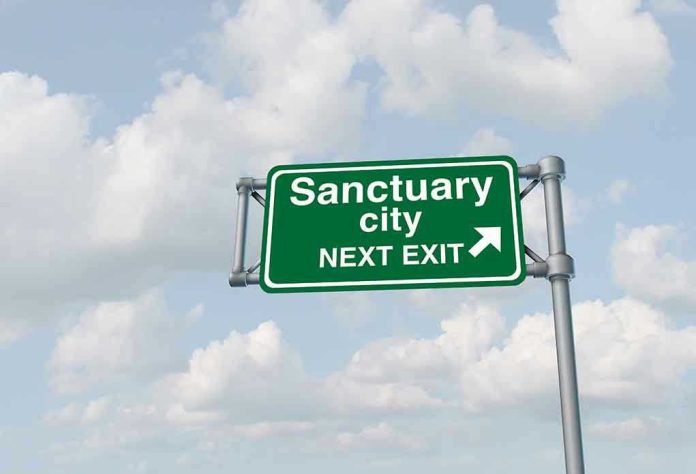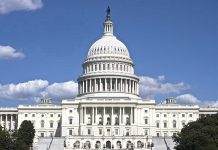
The Justice Department’s new crackdown on sanctuary jurisdictions exposes a high-stakes battle over immigration enforcement, federal law, and the safety of American communities.
Story Snapshot
- The DOJ published an official list of 35 sanctuary jurisdictions, threatening legal action against those defying federal immigration law.
- Attorney General Pam Bondi asserts these sanctuary policies endanger public safety and undermine federal authority.
- Some cities have already changed their policies under DOJ pressure, while others continue to fight in federal court.
- The list is not exhaustive and will be updated, highlighting ongoing national tensions over immigration and state/local autonomy.
DOJ Escalates Pressure on Sanctuary Cities
On August 5, 2025, the Department of Justice, under Attorney General Pam Bondi, released a list of 35 cities, counties, and states classified as “sanctuary jurisdictions”—localities that limit cooperation with federal immigration enforcement. The DOJ made it clear that legal action is forthcoming for jurisdictions refusing to comply, citing federal law and the need to protect American citizens. This move follows an executive order signed by President Trump earlier this year, mandating the DOJ to identify and litigate against sanctuary policies.
The DOJ’s approach is two-pronged: publicizing the list to apply public pressure and threatening litigation to force compliance. Some places, such as Louisville, Kentucky, have already modified their policies in response. However, others like Chicago have fought back and prevailed in court, with a federal judge in Illinois dismissing a DOJ lawsuit and upholding local sanctuary policies. These legal battles highlight the deep divisions between federal priorities and local autonomy, especially in Democrat-led areas.
Historical Context and Political Stakes
Sanctuary policies in the United States have roots in the 1980s, when cities began limiting cooperation with federal immigration authorities to shield undocumented immigrants from deportation and foster trust with local police. There is no single legal definition of a “sanctuary city,” but the term generally refers to places that restrict local law enforcement from honoring federal immigration detainers or sharing information with ICE. The Trump administration, both in its first and current terms, has prioritized aggressive enforcement and sought to penalize such jurisdictions by threatening to withhold funds and pursue litigation.
The Biden administration, by contrast, deprioritized legal battles over sanctuary cities, but the issue remained politically charged. The new DOJ list signals a return to the hardline stance favored by conservatives, who argue that sanctuary policies endanger citizens and erode the rule of law. The DOJ’s actions have reignited national debates over federalism, immigration, and the constitutional limits of federal versus state and local authority.
Legal and Social Implications of DOJ Actions
The DOJ’s publication of the sanctuary list is not final; it is described as “not exhaustive,” with further updates promised as more data is collected. Legal uncertainty now hangs over all jurisdictions named, and more lawsuits are expected in the coming months. The courts have so far issued mixed rulings: while some cities have changed course under federal pressure, others have successfully defended their autonomy, citing constitutional protections—particularly the Tenth Amendment, which limits federal power to compel local action.
For sanctuary jurisdictions, the stakes are high. They face potential loss of federal funding, costly litigation, and political pressure from both the federal government and their own constituents. For immigrant communities, shifts in local policy could mean a greater risk of detention and deportation. Law enforcement agencies warn that forced cooperation with ICE could erode trust with immigrant populations, making communities less safe by discouraging crime reporting.
The economic impact is also significant, as legal battles consume local resources and the threat of losing federal funds looms large. Social tensions are likely to intensify, further polarizing the national debate over immigration and the limits of government authority. With ongoing litigation and the possibility of Supreme Court involvement, these battles may set lasting precedents for federalism and immigration law.
Expert Perspectives and the Path Forward
Immigration policy experts and legal scholars remain divided. Organizations like the Center for Immigration Studies highlight the widespread and varied nature of sanctuary policies, while legal experts caution that the federal government’s reach is constitutionally limited. Supreme Court precedents, such as Printz v. United States, have often sided with localities on the grounds that the federal government cannot compel local law enforcement to carry out federal tasks. Critics of sanctuary policies argue they undermine law and public safety, while supporters claim they are essential for community trust and upholding constitutional principles.
Attorney General Bondi has pledged to continue DOJ litigation and work with the Department of Homeland Security to eliminate what she calls “harmful policies.” The DOJ’s aggressive stance is widely supported among conservatives who see sanctuary policies as a symbol of government overreach and a direct threat to American citizens. As legal battles continue and the list evolves, the clash between federal authority and local autonomy will remain a defining issue in American politics, with constitutional principles and public safety at the heart of the debate.
Sources:
DOJ Publishes Official List of Sanctuary Cities
Justice Department releases a new list of sanctuary cities; Los Angeles County is not on it
Bondi DOJ names and shames 35 sanctuary cities that ‘put American citizens at risk’
US Justice Department posts list of sanctuary jurisdictions, threatens more lawsuits
Map: Sanctuary Cities, Counties, and States












